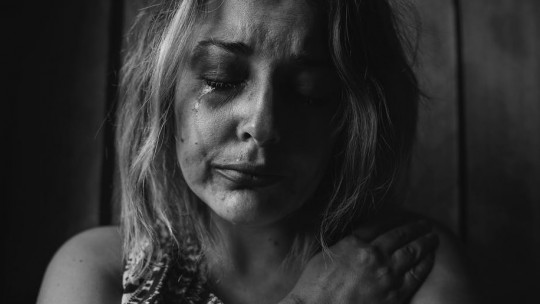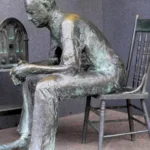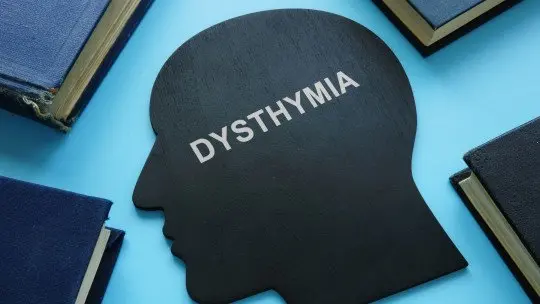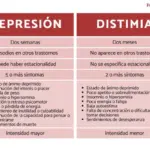
The vast majority of people have gone through moments in their lives in which they generally feel sadder, duller, apathetic and with less desire to do everything we have always liked. However, as the days go by, we rebuild ourselves and return to normal. When this mood persists, the person may be suffering from a mood disorder called dysthymia.
Dysthymia in the DSM V is part of the so-called depressive disorders, also known as chronic depression. Dysthymia has characteristics similar to major depression, but with less severity. Between 5-27% of people who suffer from major depressive disorder make the illness chronic, giving rise to dysthymia. Thus, the longer the duration of depression, the more likely it is to persist and develop a dysthymic disorder. However, chronically depressed people can recover. In this PsychologyFor article, we will help you understand What is dysthymia, its symptoms and treatment.
What is dysthymia
Dysthymic disorder or dysthymia in the DSM-V(1) It is part of the well-known mood disorders, popularly known as chronic depression, due to the persistence of its course. Specifically, the definition of dysthymia is the following: psychological disorder that implies that the person is in a depressed mood most of the time. It has a high functional impact on our daily lives, affecting all areas of the person: work, relational, cognitive, etc.
The symptoms presented in dysthymia are similar to major depressive disorder, but with a less high intensity, and with greater persistence of symptoms. Faced with this, we ask ourselves, how can I differentiate major depression from dysthymia, if they present with similar symptoms?
The difference between dysthymia and major depression is that in order to diagnose chronic depression, it is necessary that the person, in a period of two years, has not gone more than two months without presenting any of the symptoms. In this article you will find more information about the differences between dysthymia and depression.
Symptoms of dysthymia
According to the DSM-V criteria, the symptoms of dysthymia are as follows:
- Poor appetite or overeating: the disorder causes the person to considerably reduce their appetite or, on the contrary, produces the need for overeating.
- Insomnia or hypersomnia: Dysthymia produces disturbances in sleep, either due to a lack of it (insomnia) or due to excess (hypersomnia).
- Low energy or fatigue: One of the symptoms of dysthymia is a lack of energy, which greatly influences the patient’s daily functioning.
- Low self-esteem: The disorder means that the person’s self-concept is affected, as well as the perception of their abilities. Discover how to psychologically help a person with low self-esteem.
- Lack of concentration or difficulty making decisions: There is a decrease in concentration and difficulty making decisions that produce shocking frustration in the person.
- Feelings of hopelessness: It is very characteristic in the different presentations of depression. It causes the person to not contemplate a way out of the current situation, without hope for the future.
If you think you have symptoms of dysthymia, you can do this dysthymia test. To diagnose dysthmia, a medical examination and a psychological evaluation are necessary, which must be carried out by the corresponding professionals. Even so, with this dysthymia test you can guide yourself.
Causes of dysthymia
At present, the causes that produce this disorder have not been empirically demonstrated. However, it is known that it is caused by multiple factors, involving psychological, social and biological factors. Let’s see what the main causes of dysthymia are:
- Psychological and social: certain events in a person’s life that induce a depressed state of mind, such as recent losses, trauma, stress, breakups, financial problems.
- Biological: It has been observed that in depressive disorders there is a deficiency of serotonin, dopamine and/or norepinephrine in the central nervous system.
Its appearance can be early, appearing before the age of 21, or late, appearing after the age of 21. On the other hand, its severity must be specified, being classified as severe, moderate or mild.
Treatment of dysthymia
How can dysthymia be cured? To treat depressive disorders, it is highly recommended to do a combined pharmacological and psychological treatment. It is very important that treatment be carried out in cases of dysthymia, due to the impact it has and the persistence of symptoms on the person’s life.
Pharmacotherapy
The pharmacological treatment of dysthymia generally consists of the administration of antidepressant drugs. There is a wide variety of antidepressant drugs and their choice will depend on the personal characteristics of each person. The antidepressant drugs currently available to treat dysthymia are the following:
- Selective serotonin reuptake inhibitors (SSRIs) such as fluoxetine.
- Serotonin and norepinephrine reuptake inhibitors (SNRIs).
- Atypical antidepressants.
- Tricyclic antidepressants.
- Monoamine oxidase inhibitors (MAOIs).
Psychotherapeutic treatment
Cognitive-behavioral therapy (CBT) has been shown to be the most effective intervention for the treatment of depressive disorders such as dysthymia. The goal of CBT is to produce a change in behavior, cognitive patterns, and emotions of the person suffering from depression. However, an intervention can also be carried out from any psychotherapeutic orientation.
How cognitive behavioral therapy works
The person with a depressive disorder tends to have a set of irrational automatic thoughts that invade your daily life and have an impact on your behavior, for example: “what difference does it make if I don’t do anything, if I will do everything wrong?” The person has this thought automated and it arises naturally, without thinking about it, being an irrational thought that lasts over time and causes the depressed mood to persist.
CBT seeks to change these irrational thought patterns for healthier and more rational thoughts, through the technique of cognitive restructuring. By changing this set of irrational thoughts that maintain the symptoms, the person’s behaviors will change.
On the other hand, it is very common for people with depression to present peaks of anxiety and stress. Faced with this, in cognitive-behavioral therapy, the therapist teaches the patient certain strategies to reduce anxiety levels when they occur, such as relaxation techniques or improving problem-solving skills.
The CBT intervention can be carried out in individual sessions, as well as in family or group sessions.
This article is merely informative, at PsychologyFor we do not have the power to make a diagnosis or recommend a treatment. We invite you to go to a psychologist to treat your particular case.
If you want to read more articles similar to Dysthymia: what it is, symptoms and treatment we recommend that you enter our Clinical Psychology category.
- American Psychiatric Association. (2014). DSM-5. Diagnostic and Statistical Manual of Mental Disorders. Madrid: Editorial Médica Panamericana, SA
Bibliography
- Baringoltz, S. (2007). Cognitive therapy and depression. Integration of cognitive contributions to psychotherapy and Cognitive Therapy.
- Jiménez-Maldonado, M., Gallardo-Moreno, G., Villaseñor-Cabrera, T & González-Garrido, A. (2013). Dysthymia in the clinical context. REV COLOMB PSIQUIAT, 42(2), 212-218.
- Royal College of Psychiatrists. (2009). Cognitive-Behavioral Therapy (CBT). Spanish Society of Psychiatry (SEP).
- Ruiz, M., Díaz, M & Villalobos, A. (2012). Manual of Cognitive-Behavioral Intervention Techniques. Bilbao: Editorial Desclée De Brouwer, SA








